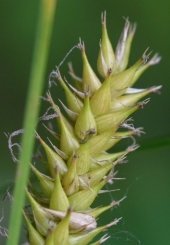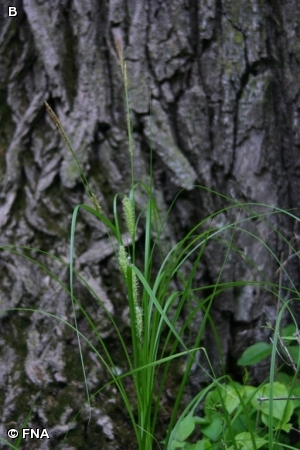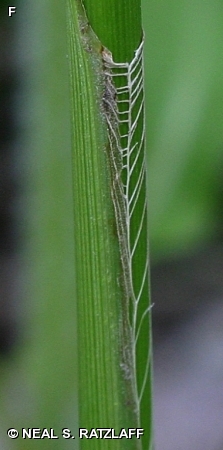
Rhizomatous perennial with flowering stems from 1-4 feet tall usually extending above the arching, narrow leaves which are up to 1/3 inch wide. Above are 2-6 separate brown male spikes with the erect female spikes well below (B,C). The rounded, green to yellow perigynia have 3 stigmas and long, tapered beaks with 2 prominent teeth which often diverge slightly (D). The reddish tinged female scales (E) fade as the perigynia mature (A). The firm, rounded lower stem has sheaths that often become dissected into laddered threadlike fibers as they mature (F).
Wet areas including marshes, streambanks, ditches, lowland woods, wet prairies. In Fontenelle Forest, Smoothcone Sedge is common along South Stream Trail and locally along the east side of the boardwalk just before one reaches the blind. At Neale Woods it is locally common on Missouri River Ecology Trail in a wet area near Rock Creek. Flowering occurs in late April and early May. The perigynia persist well into July.
Emory’s Sedge (Carex emoryii), a floodplain sedge occurring in similar sites, has flat, lens-shaped perigynia with short beaks and no teeth. They are very different from the toothed and rounded perigynia of Smoothcone Sedge. Separating the very similar Shoreline Sedge (Carex hyalinolepis) is more difficult. Close examination with a hand lens will show the perigynia of Smoothcone Sedge to have larger teeth. Other perhaps more easily identifiable field marks are its narrower, graceful arching leaves and erect female spikes which are situated well below the males (B,C). Stem bases also are firmer and rounder. When present, the distinctive dissected, laddered fibers of the leaf sheaths (F), are a helpful feature.
The content of NatureSearch is provided by dedicated volunteer Naturalists of Fontenelle Forest who strive to provide the most accurate information available. Contributors of the images retain their copyrights. The point of contact for this page is: Neal Ratzlaff.





